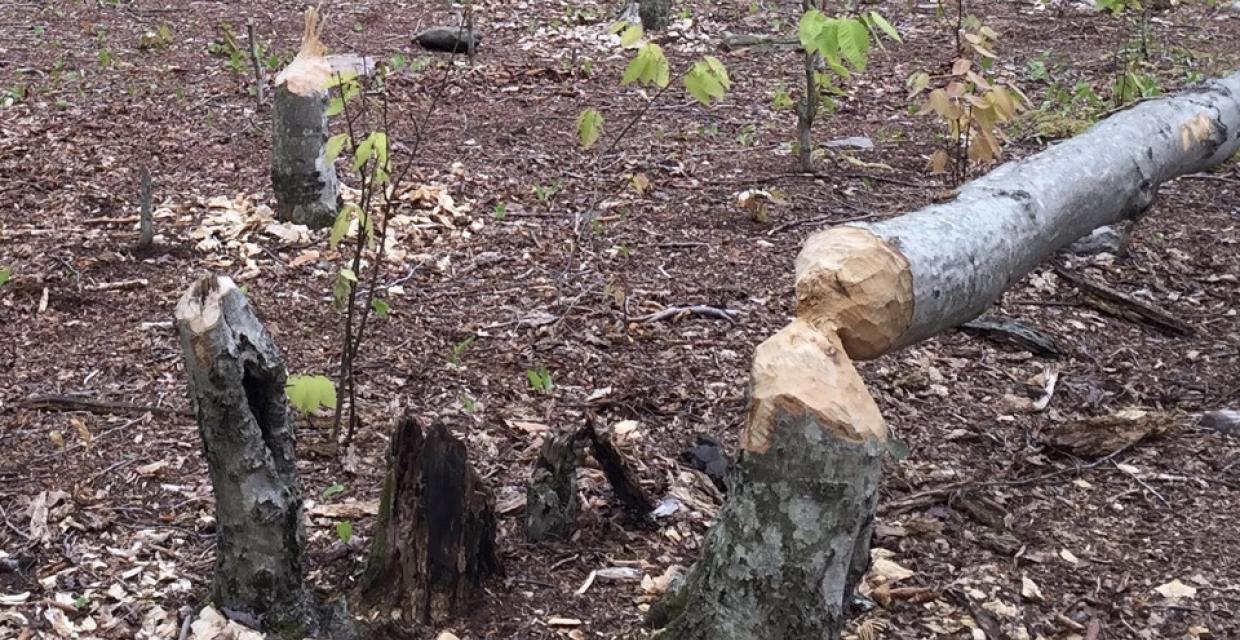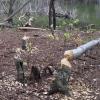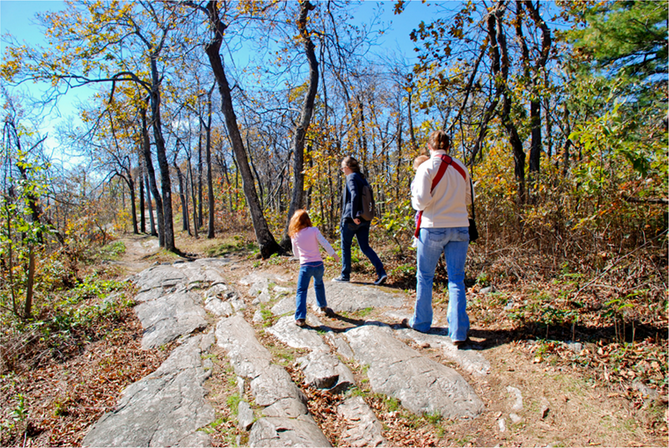Echo Lake


Destination Overview:
Echo Lake and the beavers that call it home offer serene overnight camping spots and a lean-to for small groups as a reward for several miles of moderate hiking from Platte Clove Road. Views atop Overlook Mountain, Codfish Point, and of a 70-foot waterfall are all photo-worthy.
Park Description:
To begin your hike from the parking lot on Platte Cove Road, turn right onto the road and follow the aqua blazes of the Long Path. You’ll spot a red cabin on the left about 250 yards up the road. It was once used by the Platte Clove Preserve’s Artists-in-Residence program.
To visit the 70-foot Plattekill Falls before you begin the hike to Echo Lake, turn left on the gravel drive and head downhill towards the red cabin. Stay left of the cabin and the split rail fence and follow the blue diamond markers of the Platte Clove Preserve as it follows a ledge cut into the canyon wall and then descends, sometimes steeply, to base of the waterfall. Retrace your steps and arrive back at the red cabin having logged the first half-mile of your hike, as well as the steepest descent and climb.
From the red cabin, follow the aqua blazes a few more steps along Platte Clove Road until you see the trailhead and trail register downhill on your left. Sign in and make your way across the replica kingpost bridge, which was rebuilt recently by Trail Conference volunteers. The trail follows historic Old Overlook Road, which was constructed in the early 1800’s to access the many bluestone quarries. The trail is blazed with aqua Long Path markers as well as the green diamond markers of Platte Clove Preserve.
At the “camping prohibited” sign 1.3 miles into the hike, you will be leaving Platte Clove Preserve and the aqua and green trail markers will be replaced by round blue markers. Keep an eye out for a clearing on the left. It’s an old bluestone quarry where a seating arrangement has been constructed out of stone slabs. Shortly after this quarry, the red-blazed Devil’s Path joins in from the right for a short distance then leaves to the right. Continue straight following the circular blue blazes.
The trail passes directly in front of the Devil’s Kitchen lean-to 1.75 miles into the hike then crosses a footbridge over a creek with pretty cascades. In another .7 mile, watch for a yellow-blazed side trail to the left for a short walk to Codfish Point with sweeping Hudson Valley views on the left and an abandoned bluestone quarry on the right. Retrace your steps back to the blue trail and turn left to continue to Echo Lake.
From Codfish Point, hike 1.3 miles and turn right on the yellow-blazed trail and descend about 450 feet in a .5 mile to reach Echo Lake. Camping at Echo Lake is allowed in designated areas. A lean-to is located to the left of the trail and a half-dozen campsites are evenly spaced around the lake.
To visit Overlook Mountain and take in views of the Hudson River and explore the Overlook Mountain House ruins from Echo Lake, hike back up the yellow trail and turn right on the blue trail heading toward Overlook Mountain. Turn left to hike 4.4 miles and return to where you parked at Platte Clove Road.
Heading toward Overlook Mountain on the blue trail, pass through an open gate with a stop sign at the 6.8-mile point. To visit the Overlook Mountain House ruins, continue straight a short distance on the red-blazed trail . Return to this intersection and head up the hill on your right to finish your ascent of Overlook Mountain and climb the fire tower.
Overlook Mountain rises to 3,140 feet, offering sweeping views of the entire Mid-Hudson region on a clear day, especially from the top of the fire tower.
From the top of Overlook Mountain, walk back down the hill and turn right on the blue trail to begin the hike back to the car. Follow the blue markers all the way back to the aqua-blazed Long Path in Platte Clove Preserve. Follow the Long Path back across the kingpost bridge to the trailhead and along Platte Clove Road to the parking lot.
Alert details:
- Overnight backpacking requires careful preparation. Make sure you have reviewed the list of 10 Hiking Essentials.
- Practice Leave No Trace principles when camping at Echo Lake and anytime you step into the backcountry. If you pack it in, pack it out
Echo Lake and the beavers that call it home offer serene overnight camping spots and a lean-to for small groups as a reward for several miles of moderate hiking from Platte Clove Road. Views atop Overlook Mountain, Codfish Point, and of a 70-foot waterfall are all photo-worthy.
To begin your hike from the parking lot on Platte Cove Road, turn right onto the road and follow the aqua blazes of the Long Path. You’ll spot a red cabin on the left about 250 yards up the road. It was once used by the Platte Clove Preserve’s Artists-in-Residence program.
To visit the 70-foot Plattekill Falls before you begin the hike to Echo Lake, turn left on the gravel drive and...
- Overnight backpacking requires careful preparation. Make sure you have reviewed the list of 10 Hiking Essentials.
- Practice Leave No Trace principles when camping at Echo Lake and anytime you step into the backcountry. If you pack it in, pack it out
Hike Checklist:
Whether you are going for a day hike or backpacking overnight, it is good practice to carry what we call The Hiking Essentials. These essentials will help you enjoy your outing more and will provide basic safety gear if needed. There may also be more essentials, depending on the season and your needs.
The Essentials
Hiking Shoes or Boots
Water - Two quarts per person is recommended in every season. Keep in mind that fluid loss is heightened in winter as well as summer. Don't put yourself in the position of having to end your hike early because you have run out of water.
Map - Know where you are and where you are going. Many of our hiking areas feature interconnecting network of trails. Use a waterproof/tear-resistant Tyvek Trail Conference map if available or enclose your map in a Ziplock plastic bag. If you have a mobile device, download Avenza’s free PDF Maps app and grab some GPS-enhanced Trail Conference maps (a backup Tyvek or paper version of the map is good to have just in case your batteries die or you don't have service). Check out some map-reading basics here.
Food - Snacks/lunch will keep you going as you burn energy walking or climbing. Nuts, seeds, and chocolate are favorites on the trail.
Sunscreen and insect repellent
Rain Gear and Extra Clothing - Rain happens. So does cold. Be prepared for changing weather. Avoid cotton--it traps water against your skin and is slow to dry. If you are wearing wet cotton and must return to your starting point, you risk getting chills that may lead to a dangerous hypothermia. Choose synthetic shirts, sweaters and/or vests and dress in layers for easy on and off.
Compass - A simple compass is all you need to orient you and your map to magnetic north.
Light - A flashlight or small, lightweight headlamp will be welcome gear if you find yourself still on the trail when darkness falls. Check the batteries before you start out and have extras in your pack.
First Aid Kit - Keep it simple, compact, and weatherproof. Know how to use the basic components.
Firestarter and Matches - In an emergency, you may need to keep yourself or someone else warm until help arrives. A firestarter (this could be as simple as leftover birthday candles that are kept inside a waterproof container) and matches (again, make sure to keep them in a waterproof container) could save a life.
Knife or Multi-tool - You may need to cut a piece of moleskin to put over a blister, repair a piece of broken equipment, or solve some other unexpected problem.
Emergency Numbers - Know the emergency numbers for the area you're going to and realize that in many locations--especially mountainous ones, your phone will not get reception.
Common Sense - Pay attention to your environment, your energy, and the condition of your companions. Has the weather turned rainy? Is daylight fading? Did you drink all your water? Did your companion fail to bring rain gear? Are you getting tired? Keep in mind that until you turn around you are (typically) only half-way to completing your hike--you must still get back to where you started from! (Exceptions are loop hikes.)
Check the weather forecast before you head out. Know the rules and regulations of the area.
The Leave No Trace Seven Principles
Plan Ahead and Prepare
- Know the regulations and special concerns for the area you'll visit.
- Prepare for extreme weather, hazards, and emergencies.
- Schedule your trip to avoid times of high use.
- Visit in small groups when possible. Consider splitting larger groups into smaller groups.
- Repackage food to minimize waste.
- Use a map and compass to eliminate the use of marking paint, rock cairns or flagging.
Travel and Camp on Durable Surfaces
- Durable surfaces include established trails and campsites, rock, gravel, dry grasses or snow.
- Protect riparian areas by camping at least 200 feet from lakes and streams.
- Good campsites are found, not made. Altering a site is not necessary.
- In popular areas:
- Concentrate use on existing trails and campsites.
- Walk single file in the middle of the trail, even when wet or muddy.
- Keep campsites small. Focus activity in areas where vegetation is absent.
- In pristine areas:
- Disperse use to prevent the creation of campsites and trails.
- Avoid places where impacts are just beginning.
- Pack it in, pack it out. Inspect your campsite and rest areas for trash or spilled foods. Pack out all trash, leftover food and litter.
- Deposit solid human waste in catholes dug 6 to 8 inches deep, at least 200 feet from water, camp and trails. Cover and disguise the cathole when finished.
- Pack out toilet paper and hygiene products.
- To wash yourself or your dishes, carry water 200 feet away from streams or lakes and use small amounts of biodegradable soap. Scatter strained dishwater.
- Preserve the past: examine, but do not touch cultural or historic structures and artifacts.
- Leave rocks, plants and other natural objects as you find them.
- Avoid introducing or transporting non-native species.
- Do not build structures, furniture, or dig trenches.
- Campfires can cause lasting impacts to the backcountry. Use a lightweight stove for cooking and enjoy a candle lantern for light.
- Where fires are permitted, use established fire rings, fire pans, or mound fires.
- Keep fires small. Only use sticks from the ground that can be broken by hand.
- Burn all wood and coals to ash, put out campfires completely, then scatter cool ashes.
- Observe wildlife from a distance. Do not follow or approach them.
- Never feed animals. Feeding wildlife damages their health, alters natural behaviors, and exposes them to predators and other dangers.
- Protect wildlife and your food by storing rations and trash securely.
- Control pets at all times, or leave them at home.
- Avoid wildlife during sensitive times: mating, nesting, raising young, or winter.
Be Considerate of Other Visitors
- Respect other visitors and protect the quality of their experience.
- Be courteous. Yield to other users on the trail.
- Step to the downhill side of the trail when encountering pack stock.
- Take breaks and camp away from trails and other visitors.
- Let nature's sounds prevail. Avoid loud voices and noises.
The Trail Conference is a 2015 Leave No Trace partner.
(c) Leave No Trace Center for Outdoor Ethics: www.LNT.org.





Last August I went on an overnight trip to Echo Lake. The route we planned was from Platte's Clove to Echo Lake then up Overlook and back to Echo Lake for the night. Normally I would go from Overlook to the lake (Which is WAY shorter), but we figured we would try something different this time (I know, I'm wild).
The first part of the hike was nice, going through the woods along some old bluestone quarries and with some awesome views of the Hudson Valley. Someone made a bunch of benches out of the stone, and they're surprisingly comfortable after a couple of miles with a loaded pack.
Eventually you come across a lean-to alongside a creek. It would make a great campsite, but it was already taken and it was no where near out destination.
There is a long while before getting to anything of note, and that would probably be the turn off for Echo Lake. The walk is down a rocky hill, and it's kind of difficult to walk down the hill with out bouncing from rock to rock. Unless you're a kangaroo or ballerina, it'd probably be difficult to make it down without all the side stepping.
Finally at the bottom, is Echo Lake. There is a lean-to right at the end of the trail, but the best places to camp are on the trail circling the lake. We stayed in a pine forest with a great fire-pit. There were not many people there, except a man at the campsite next to us, and a guy named Tim (who may or may not be a paper lantern salesman), but there are a lot of beavers. The forest around the lake and the trees on the shore have been massacred by the beavers, but they did leave us some good kindling and fire wood.
We set up camp here, and then headed back up the trail towards Overlook. It is a pretty steep hike, but definitely worth it. The old Mountain House is amazing, but you have to be there at the right time. When we got there, a million people were already swarming the building and shouting. My favorite was the guy talking about the Monks that lived in the old building and burned it down when the redcoats were coming. I wish I was making that up.
We continued on to the fire tower and avoided rattlesnake territory, then turned back around and headed back to Echo Lake. When we finally got back we were exhausted and ready to start our fire. We had to make utensils out of sticks, and then we could enjoy our chipotle chicken (So good).
No bears bothered us during the night, though I have heard this is the bear capital of the Catskills.
We woke up early and hiked out the way we came. This is probably my new favorite overnight in the area, and I recommend this to everyone who's looking for a one night camping trip.